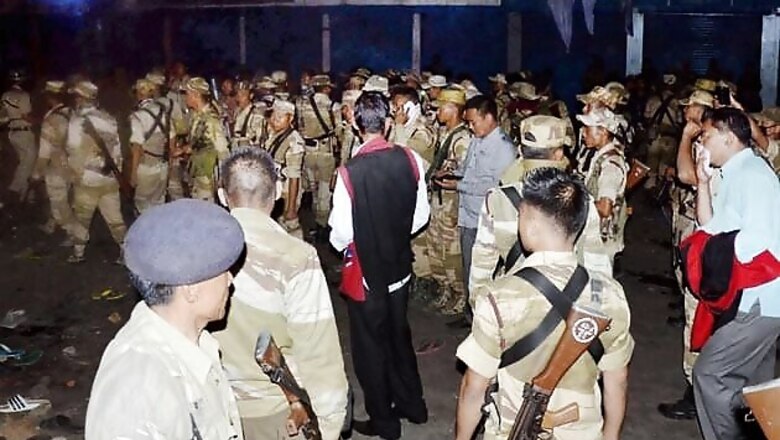
views
When Gotham was under siege, 'justice' was fast and decisive. The League of Shadow offered its prisoners multiple options to choose death from. Gotham is a fictional city but Dimapur isn't. Though what unfolded here on Thursday evening did challenge us to suspend that sense of disbelief.A mob of 7,000-8,000 people reached the ramshackle building that serves as the central jail, overpowered the Nagaland Armed Police guards and snatched the custody of Syed Farid Khan, an accused in a sexual assault case. The mob assaulted him throughout the stretch of over eight kilometres and finally hung him from the city tower.
When I reached Dimapur next day, the splatter of blood at the tower stood out against the eerie silence that had engulfed the town. Curfew always makes its presence felt, scared faces though have a different language. While I got various versions from the onlookers, along the route taken by the vigilante mob, none agreed to speak on camera. When I tried to reason it out with one such gentleman, he silenced me with a single sentence: You will go back to Delhi but I will have to live my life here.
The geography & demographic
Dimapur shares porous border with Assam on three sides. It is the only town of Nagaland where you can live without an Inner Line Permit. It has the state's main railway station and the only airport. It is also the headquarters of the 3 Corps of the Indian Army. In short, Dimapur is the world's gateway to Nagaland. Needless to say, the impact is visible in the demography of the town as well.

Since the town sits in the pocket of Karbi-Alaong region of Assam, the influx of Assamese population is evident. It also has a significant Marwari business community, who like everywhere else, control the main businesses of the border town. Dimapur has traditionally been home to a significant Muslim population as well. The grand old mosque of Dimapur was built in 1906, at the heart of the city. The city's famous Hong Kong market was built on land donated by a noted member of the Muslim community. By 1930s they have had a proper graveyard in the city, on Anwar Hussain Road. In fact Dimapur 1, the only non reserved seat in the Nagaland Assembly, has even chosen Muslim MLAs in the past.
Post 1971 war and Bangladesh's independence, this town like all the adjoining regions have seen a steady influx of Bangladeshi immigrants. Dimapur, like Assam and West Bengal has seen this phenomena snowball into a major issue. And the genesis of this ghastly vigilante justice, probably lies in this.
Dimapur today
Most of the city's businesses are in the hands of the outsiders. Marwaris and Muslims are the two communities who have the lion's share of the businesses in the town. The local Naga communities have traditionally been farmers and worked either for the forces or the government.

But with government jobs on the decline and unemployment gaining ground, the Naga youths are now eager to become entrepreneurs. The president of the Business Association of Nagas (BAN), Mar Longkumer says that if the business licenses of the Illegal Bangladeshi Immigrant (IBI) are cancelled then a number of indigenous people can get to do businesses instead. Over the years radical Naga groups like Survival Nagaland and others have also come up to feeding to these needs and insecurities of the native Naga people.
The allegation of rape
The rape complaint against Syed Farid Khan was filed by a woman who is from the same village as Farid's wife. According to the complainant, she knew him as he used to stay in the same neighbourhood. She in her statement (which CNN-IBN is in possession of) claims that a co-accused, who was her friend, asked her out to have a meal around 9:30 pm. But instead he led her to him. Farid allegedly drove off to an area called 4 Mile, without Ngukavi (the co-accused). Farid and her were the only two people in the car, at that point of time. "As soon as the car took off the main accused snatched my phone and switched it off. I thought of jumping off the car but the main accused drove the car in full speed. He then took me to an isolated place of forest area near 4th Mile."
She then alleges that the "accused caught hold of my hand and forced beer into my throat, when I hesitated he began to torture me and threatened me that he would kill me and so fearing for my life I could not do anything." She claims she was later taken to a hotel where she was allegedly raped twice.
She further states "the accused handed over Rs 5,000 which I refused but he threatened me again with dire consequences if I did not accept the money". Complaint was submitted on February 24, the morning after the alleged crime took place.
When asked about the case IG, Range, Wabang Zamir, who has been specially sent from Kohima to monitor the probe, says: "we had registered the case on the basis of the girl's complaint. We sent her for medical examination where we found minor injuries to her thumb. We have sent the vaginal swab to the FSL labs and are awaiting the results."
Some of the local TV channels have been running CCTV visuals of the girl walking in and out of the hotel, the video has not been corroborated by the police yet. People close to the complainant says only two of the three sets of CCTV footage have been leaked. There apparently is a third set of footage where she is seen to be in a semi-conscious state.
These cases of rape, however unfortunate, are reported often across the country. As a Nagaland MLA Mmhonlumo Kikon points out, the state has a conviction rate of 72 per cent in cases of sexual assault, much better than the national average. So a proper probe would have possibly taken the case to its logical conclusion.
Who was Sayed Farid Khan?
Son of a former BSF serviceman, he ran a business of selling used cars. He had been staying in Dimapur for years and had married a Naga woman (a common practice in the region, as non-Nagas cannot own land in Nagaland).
He was originally from Karimganj in Assam and contrary to the popular notion he was not an 'IBI' (the Illegal Bangladeshi Immigrant). He has seven siblings, two of them employed with the Indian Army.
Before the mob attack:
Tension was brewing in Dimapur with groups like Naga Students Federation and Survival Nagaland constantly raising the issue of illegal Bangladeshi immigrants. In this vitiated atmosphere when a rape complaint was filed where the accused had a surname which is often associated with the IBIs, the groups realised that they had an issue which was emotive enough to galvanise the entire community.
A Rehman, President of the Dimapur Muslim Council (DMC) agrees that "often local Muslims are confused for illegal Bangladeshi immigrants because of their shared culture," he goes on to add that often they are blamed for the crimes committed by IBIs.
The situation in Dimapur was tense at for least three days before the march to jail took place. Section 144 was imposed in the town which prohibited gathering of more than five people at a place. But NSF wanted to hold a 'peaceful' protest against crime against women on March 5. The administration gave permission for this, thereby making a humongous mistake which the Nagaland CM later accepted.
The bloody march
Nothing but a total intelligence and administrative failure can explain what happened that afternoon. The protesters grew in number as hours went by. Provocative speeches seeking total cancellation of all licenses and the businesses in the hands of IBIs were made. Videos of the day show blood curling slogans against a particular community being raised.

It appears no one checked the background of Farid. Conveniently branded as an IBI, he became the focal point of an already angry mob. The 8,000 strong crowd was mostly comprised of students between 17-20 years of age. And no one knows when the crowd turned towards the jail and overpowered the Nagaland Armed Policemen to take the final custody of Farid.
From the investigation so far, the police are ruling out any possible conspiracy theory. Police say prima facie it appears to be a case of spontaneous anger which horribly went out of control. A mob of mainly college and high school students, provoked by certain others decided to make a mockery of the law and justice system.
The reaction:
Across the party, race, religious and ethnic lines, leaders have come forward to condemn the killing. But the fissures of the society become clearer when you listen to what they have to say after the customary condemnation.
Mar Longkumer of BAN, condemns the incident in 'strongest of words' but goes on to add that such incidents would rise if the issue of IBIs are not resolved. What is worrying is he is supported by a number of other Naga leaders in Dimapur.
A Rehman of the DMC claims that the attack has left local Muslim population feeling extremely vulnerable. While he speaks for the need to regulate the IBIs, he is concerned over the news of exodus of thousands of people from Dimapur to Assam.
The last word
Farid, it appears, has become a victim of the identity mistakenly or conveniently bestowed upon him. The mob targeted him more for his perceived IBI identity and his alleged crime only acted as the spark. However, there doesn't appear to be any direct link between the alleged rape victim and this violent mob. While ascertaining the veracity of the rape complaint is that of the police and they should be allowed to do the job. This vigilante justice system should be criticised in the strongest possible manner. And finally the city deserves a better police force. One that can actually protect the vulnerable, if ever such community based targeting happens again.




















Comments
0 comment